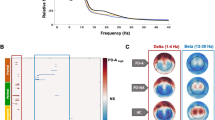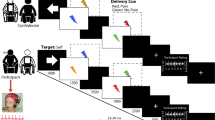Abstract
Panic attacks, the cardinal symptom of panic disorder (PD), are characterized by intense physiological reactions including accelerated heart activity. Although cortical processes are thought to trigger and potentiate panic attacks, it is unknown whether individuals with PD have a general tendency to show elevated cortico–cardiac interactions, which could predispose them for brain-driven modulations of heart activity during panic. Consistent with this hypothesis, serotonin, a highly relevant neurotransmitter for panic and PD presumably affects the cortical control of the heart. The current study thus aimed to test whether PD and serotonin reuptake inhibitor (SRI) intake are related to cortico–cardiac interactions in the absence of acute panic. Human participants with PD (N=22), major depression (MD, clinical control group, N=21) or no psychiatric diagnosis (healthy control group, N=23) performed a gambling task. To measure cortico–cardiac coupling, the within-subject covariation of single-trial EEG after feedback presentation and subsequent changes in heart period was determined. As in prior studies, there was a significant time-lagged covariation of EEG and heart activity indicating that trial-by-trial fluctuations of feedback-evoked EEG amplitude determined how much heart activity accelerated seconds later. Importantly, this covariation pattern was significantly potentiated in PD vs control participants. Moreover, concurrent SRI intake further augmented brain–heart covariation in individuals with PD and MD. The present findings demonstrate that PD and serotonin are associated with altered brain–heart interactions in a non-panic situation. Future work should clarify whether brain–heart coupling has a causal role in PD, for example by facilitating panic attacks.
Similar content being viewed by others
Log in or create a free account to read this content
Gain free access to this article, as well as selected content from this journal and more on nature.com
or
References
Aronson TA, Carasiti I, McBane D, Whitaker-Azmitia P (1989). Biological correlates of lactate sensitivity in panic disorder. Biol Psychiatry 26: 463–477.
Barlow DH, Vermilyea J, Blanchard EB, Vermilyea BB, Di Nardo PA, Cerny JA (1985). The phenomenon of panic. J Abnorm Psychol 94: 320–328.
Beck AT, Steer RA, Ball R, Ranieri W (1996). Comparison of Beck Depression Inventories -IA and -II in psychiatric outpatients. J Pers Assess 67: 588–597.
Bouton ME, Mineka S, Barlow DH (2001). A modern learning theory perspective on the etiology of panic disorder. Psychol Rev 108: 4–32.
Carney RM, Blumenthal JA, Stein PK, Watkins L, Catellier D, Berkman LF et al (2001). Depression, heart rate variability, and acute myocardial infarction. Circulation 104: 2024–2028.
Chambless DL, Caputo GC, Bright P, Gallagher R (1984). Assessment of fear of fear in agoraphobics: the body sensations questionnaire and the agoraphobic cognitions questionnaire. J Consult Clin Psychol 52: 1090–1097.
Clark CR, McFarlane AC, Weber DL, Battersby M (1996). Enlarged frontal P300 to stimulus change in panic disorder. Biol Psychiatry 39: 845–856.
Clark DM (1986). A cognitive approach to panic. Behav Res Ther 24: 461–470.
Cools R, Roberts AC, Robbins TW (2008). Serotoninergic regulation of emotional and behavioural control processes. Trends Cogn Sci 12: 31–40.
Cowley DS, Hyde TS, Dager SR, Dunner DL (1987). Lactate infusions: the role of baseline anxiety. Psychiatry Res 21: 169–179.
Critchley HD, Mathias CJ, Josephs O, O'Doherty J, Zanini S, Dewar BK et al (2003). Human cingulate cortex and autonomic control: converging neuroimaging and clinical evidence. Brain 126: 2139–2152.
David SP, Murthy NV, Rabiner EA, Munafo MR, Johnstone EC, Jacob R et al (2005). A functional genetic variation of the serotonin (5-HT) transporter affects 5-HT1A receptor binding in humans. J Neurosci 25: 2586–2590.
Delorme A, Makeig S (2004). EEGLAB: an open source toolbox for analysis of single-trial EEG dynamics including independent component analysis. J Neurosci Methods 134: 9–21.
Ehlers A, Breuer P (1992). Increased cardiac awareness in panic disorder. J Abnorm Psychol 101: 371–382.
Eysenck HJ (1970) The Structure of Human Personality. Meuthen & Co: London, UK.
Friedman BH, Thayer JF (1998). Autonomic balance revisited: panic anxiety and heart rate variability. J Psychosom Res 44: 133–151.
Gaffney FA, Fenton BJ, Lane LD, Lake CR (1988). Hemodynamic, ventilatory, and biochemical responses of panic patients and normal controls with sodium lactate infusion and spontaneous panic attacks. Arch Gen Psychiatry 45: 53–60.
Goldstein BJ, Goodnick PJ (1998). Selective serotonin reuptake inhibitors in the treatment of affective disorders—III. Tolerability, safety and pharmacoeconomics. J Psychopharmacol 12: S55–S87.
Gorman JM, Kent JM, Sullivan GM, Coplan JD (2000). Neuroanatomical hypothesis of panic disorder, revised. Am J Psychiatry 157: 493–505.
Graeff FG, Del-Ben CM (2008). Neurobiology of panic disorder: from animal models to brain neuroimaging. Neurosci Biobehav Rev 32: 1326–1335.
Grippo AJ, Beltz TG, Weiss RM, Johnson AK (2006). The effects of chronic fluoxetine treatment on chronic mild stress-induced cardiovascular changes and anhedonia. Biol Psychiatry 59: 309–316.
Hayward C, Killen JD, Kraemer HC, Taylor CB (2000). Predictors of panic attacks in adolescents. J Am Acad Child Adolesc Psychiatry 39: 207–214.
Jordan D (2005). Vagal control of the heart: central serotonergic (5-HT) mechanisms. Exp Physiol 90: 175–181.
Kemper CJ (2010) Das Persönlichkeitsmerkmal Angstsensitivität: Taxon oder Dimension?. Verlag Dr Kovač: Hamburg, Germany.
Kendler KS, Gardner CO, Prescott CA (2001). Panic syndromes in a population-based sample of male and female twins. Psychol Med 31: 989–1000.
Licht CM, de Geus EJ, van Dyck R, Penninx BW (2010). Longitudinal evidence for unfavorable effects of antidepressants on heart rate variability. Biol Psychiatry 68: 861–868.
Margraf J (1990). Ambulatory psychophysiological monitoring of panic attacks. 1990. J Psychophysiol 4: 321–330.
Margraf J (1994) Mini-DIPS: Diagnostisches Kurz-Interview bei psychischen Störungen. Springer: Berlin (Germany).
McNally RJ (1990). Psychological approaches to panic disorder: a review. Psychol Bull 108: 403–419.
Mueller EM, Evers EA, Wacker J, van der Veen FM (2012). Acute tryptophan depletion attenuates brain-heart coupling following external feedback. Front Hum Neurosci 6: 77.
Mueller EM, Makeig S, Stemmler G, Hennig J, Wacker J (2011). Dopamine effects on human error processing depend on catechol-o-methyltransferase VAL158MET genotype. J Neurosci 31: 15818–15825.
Mueller EM, Stemmler G, Hennig J, Wacker J (2013). 5-HTTLPR and anxiety modulate brain-heart covariation. Psychophysiology 50: 441–453.
Mueller EM, Stemmler G, Wacker J (2010). Single-trial electroencephalogram predicts cardiac acceleration: a time-lagged P-correlation approach for studying neurovisceral connectivity. Neuroscience 166: 491–500.
Neumeister A, Bain E, Nugent AC, Carson RE, Bonne O, Luckenbaugh DA et al (2004). Reduced serotonin type 1A receptor binding in panic disorder. J Neurosci 24: 589–591.
Nieuwenhuis S, De Geus EJ, Aston-Jones G (2011). The anatomical and functional relationship between the P3 and autonomic components of the orienting response. Psychophysiology 48: 162–175.
Panitz C, Wacker J, Stemmler G, Mueller EM (2013). Brain-heart coupling at the P300 latency is linked to anterior cingulate cortex and insula—a cardio-electroencephalographic covariance tracing study. Biol Psychol 94: 185–191.
Roy-Byrne PP, Stang P, Wittchen HU, Ustun B, Walters EE, Kessler RC (2000). Lifetime panic-depression comorbidity in the National Comorbidity Survey. Association with symptoms, impairment, course and help-seeking. Br J Psychiatry 176: 229–235.
Sato A, Yasuda A, Ohira H, Miyawaki K, Nishikawa M, Kumano H et al (2005). Effects of value and reward magnitude on feedback negativity and P300. Neuroreport 16: 407–411.
Stahl SM (1998). Mechanism of action of serotonin selective reuptake inhibitors. Serotonin receptors and pathways mediate therapeutic effects and side effects. J Affect Disord 51: 215–235.
Thayer JF, Lane RD (2000). A model of neurovisceral integration in emotion regulation and dysregulation. J Affect Disord 61: 201–216.
Thayer JF, Lane RD (2009). Claude Bernard and the heart-brain connection: further elaboration of a model of neurovisceral integration. Neurosci Biobehav Rev 33: 81–88.
Trindade E, Menon D, Topfer LA, Coloma C (1998). Adverse effects associated with selective serotonin reuptake inhibitors and tricyclic antidepressants: a meta-analysis. CMAJ 159: 1245–1252.
Zanardi R, Franchini L, Gasperini M, Perez J, Smeraldi E (1996). Double-blind controlled trial of sertraline versus paroxetine in the treatment of delusional depression. Am J Psychiatry 153: 1631–1633.
Acknowledgements
This work was funded by Deutsche Forschungsgemeinschaft grant number DFG WA 2593/2-2.
Author information
Authors and Affiliations
Corresponding author
Rights and permissions
About this article
Cite this article
Mueller, E., Panitz, C., Nestoriuc, Y. et al. Panic Disorder and Serotonin Reuptake Inhibitors Predict Coupling of Cortical and Cardiac Activity. Neuropsychopharmacol 39, 507–514 (2014). https://doi.org/10.1038/npp.2013.224
Received:
Revised:
Accepted:
Published:
Issue date:
DOI: https://doi.org/10.1038/npp.2013.224



